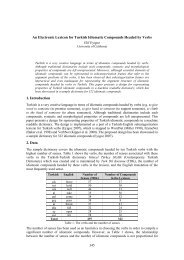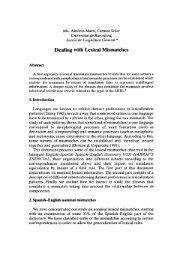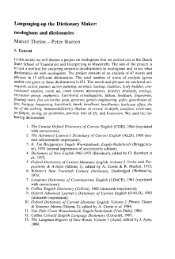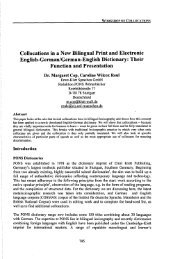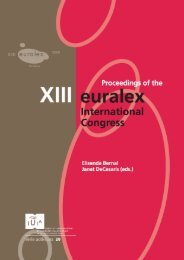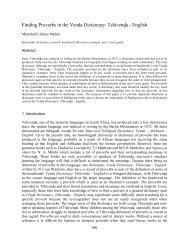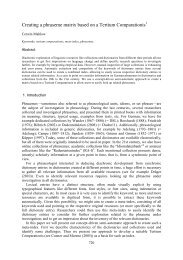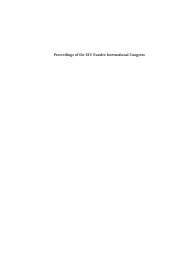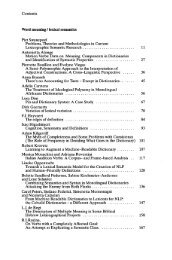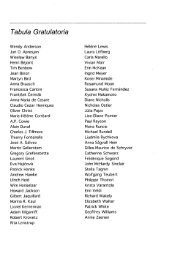Monolingual, bilingual, «interlingual» description. Some ... - Euralex
Monolingual, bilingual, «interlingual» description. Some ... - Euralex
Monolingual, bilingual, «interlingual» description. Some ... - Euralex
Create successful ePaper yourself
Turn your PDF publications into a flip-book with our unique Google optimized e-Paper software.
<strong>Monolingual</strong>, <strong>bilingual</strong>, <strong>«interlingual»</strong> <strong>description</strong>.<br />
<strong>Some</strong> remarks on a new method for the production<br />
of <strong>bilingual</strong> dictionaries'<br />
Ulrich Heid<br />
1. Introduction<br />
ln a paper published in 1988, Bernard A1' proposed a melhod for the semi-automatic<br />
preparation of contrastive lexicographic <strong>description</strong>s which could serve as an input to<br />
lhe construction of <strong>bilingual</strong> dictionaries. The basic idea of his approach, developed<br />
within lhe framework of lhe Van Dale series of monolingual and <strong>bilingual</strong> dictionaries,<br />
is to combine two <strong>bilingual</strong> dictionaries, X A and X ^ B, in order to get material<br />
for A B and B A dictionaries. The A B material can be retrieved automatically<br />
by a «conversion» procedure. 2<br />
Within the framework of a preliminary study, we had the opportunity to analyse<br />
the output of the conversion system on the basis of two extracts from German/French,<br />
French/German raw material.- 1<br />
The goal of lhc analysis was to estimate<br />
the feasibility of a large-scale application of lhe conversion procedures for lhe production<br />
of input to lexicographic work. But the results of the feasibility study are of<br />
some interest not only for lhe application of the conversion procedures in lexicographic<br />
praclice, but also for the discussion of more general questions pertaining to<br />
lhe re-use of dictionary material in natural language processing. <strong>Some</strong> of the results<br />
are of particular relevance for the construction and use of multilingual translation dictionaries.<br />
Within the present paper, we proceed from more specific problems of the actual<br />
conversion experiments to more general questions concerning the re-use of dictionaries<br />
in natural language processing.<br />
We first discuss the input to the dictionary conversion and lhe methodology of<br />
Bernard Al (1988).<br />
* The research described in this paper has been carried out under a conlract from the publishing<br />
house Dictionnaires Le Robert, Paris, and in collaboration with Van Dale and Le Robert.<br />
Thc work described here has been done together with Miriam Scheytt. Wilhoul her contribution,<br />
this presentation would not have been possible. The present text has benefited a lot<br />
from discussions ofprevious versions with Bernard Al, Alain Duval and Willy Martin, whom we<br />
would like lo thank for their constructive remarks. All errors or imprécisions are of course our<br />
own.<br />
1. This is Al (1988).<br />
2. The term «conversion» will henceforth be used for the (set of) procedure(s) described<br />
by Al (1988) which mainly reorganize lexical <strong>description</strong>s contained in lhe Van Dale dictionary<br />
databases. (Al 1988) docs nol use lhis term himsclf.<br />
3. We would like to thank Van Dale publishers and especially Bernard Al for giving us the<br />
opportunily of analysing the material.
168<br />
Then the results of lhe preliminary study are presented, from bolh a quantitative<br />
and a qualitative point of view (section 3).<br />
The fourth section deals with the main problems encountered in the assessment<br />
of the feasibility of lhe approach; there are some general limitations inherent to the<br />
philosophy underlying the Van Dale dictionary series and the conversion routines; on<br />
the other hand, we also encountered a certain number of problems originating from<br />
inconsistencies in the use of coding conventions, or simply from the use of lexicographic<br />
text-condensing devices.<br />
The last section of this paper is devoted to a generalization of the results from<br />
different points of view: the Van Dale approach to <strong>bilingual</strong> dictionaries, the ongoing<br />
discussion about the structure of <strong>bilingual</strong> dictionaries, and finally, the discussion<br />
about re-use of dictionary material in multilingual natural language processing.<br />
2. The input to dictionary conversion<br />
Before discussing the actual conversion procedure proposed by Al (1988), we should<br />
briefly describe the input to this procedure. We start with a rough <strong>description</strong> of the<br />
microstructure of the relevant Van Dale dictionaries, then discuss the philosophy of<br />
thc Van Dale series of monolingual and <strong>bilingual</strong> dictionaries, and finally outline the<br />
conversion procedure.<br />
2.1. The microstructure of the monolingual Van Dale dictionary<br />
We cannot describe here the complete microstructure of Van Dale dictionaries, and<br />
thus limit ourselves to the four main types of «information packages»:<br />
1. The headword;<br />
2. A syntactic <strong>description</strong> 4<br />
which can be generalized over all «senses» of<br />
the headword;<br />
3. A semantic <strong>description</strong> of different «senses» of the headword (keeping<br />
track of the syntactic properties);<br />
4. A <strong>description</strong> of the combinatory properties of the headword, organized<br />
according to the «senses», with collocations and example sentences.<br />
As an example, we reproduce the entry s.v. stalling, from the Dutch monolingual<br />
dictionary (Van Sterkenburg/Pijnenburg, 1984). We have separated thc information<br />
packages according to the above categories.<br />
4. Optionally, other types of information can complete this information package, e.g. variation<br />
or subject field marks, indications of thc language from which a lexeme is borrowed,<br />
etc.
'slfctHng<br />
(de-(v.);-en)<br />
0.1 loods,garage enz. wnarin rijwie|cn of auto's<br />
Worden gestald 0.2 het op sta1 brcngen of 7ettet1 Van diercn,met<br />
nanie paardèn 0.3 het in ecu loods of garage onderbrengeti vnrt rlj-<br />
wiclen,akito'settz.0.4gc!ddat men be(aalt voor hetstallen =bjto/-<br />
gtld*<br />
І.І gelegertheid tot~ van rijwkitn 2.1 eén overdekié~ bij het<br />
station 3.4 ik kom u de ~ betalen.<br />
Figure I: Components of an entry of the monolingual dictionary<br />
169<br />
We now have to take a closer look al the semantic <strong>description</strong> (i.e. at information<br />
package 3), because it is central to the argument of the present paper. As do<br />
most defining dictionaries, Van Sterkenburg/Pijnenburg (1984) also uses different<br />
devices of meaning <strong>description</strong>. They range from definition-like texts (specifying the<br />
genus proximum and the differentia specifica) over indications of synonyms to usage<br />
notes in the sense of short <strong>description</strong>s of lhe application context of a given lexical<br />
item (often interpretable as selection restrictions or domain-specific indications). No<br />
particular definition style (as in COBUILD) is used, and it seems from a rough glance<br />
at some examples lhat the devices described above (the list of which is by no<br />
means exhaustive) may co-occur in any combination. As a general rule, every<br />
«sense» has lo have one (and only one) meaning <strong>description</strong>. 5<br />
5. Thc situation may be different for other Van Dale dictionaries; lhe use of morc rigidly<br />
definable «definilion models» within thc English Dutch dictionary has been argued for by W.<br />
Martin, personal communication.
170<br />
2.2. The relationship between the monolingual and the <strong>bilingual</strong> dictionary<br />
In the previous section, we have described the microslructure of entries of Van Sterkenburg/Pijnenburg<br />
(1984). Abstracting away from the collocational part (information<br />
package 4), we can individuate pairs composed of:<br />
A Dutch headword and its syntactic (.<br />
1 and 2), and<br />
A Dutch meaning <strong>description</strong><br />
(= information package 3).<br />
.) properties (= information packages<br />
The central idea of the series of <strong>bilingual</strong> dictionaries with Dutch as a source<br />
language is now to use the set of those pairs (headword & meaning <strong>description</strong>,<br />
henceforth called «concept») «as a starling-point for the macro-structure» of the <strong>bilingual</strong><br />
dictionaries/' This means, roughly speaking, that all Dutch ^ X dictionaries<br />
contain (more or less) the same set of «concepls» lo be lexicalized in lhe respective<br />
foreign languages. The idea behind this procedure is lo view the Dutch ^ X translation<br />
dictionaries as inventories of lexicalization candidates for situations or states of<br />
affairs which Dutch-speaking people would like to speak about. 7<br />
Therefore, all <strong>bilingual</strong><br />
dictionaries of the series have the same microstructural organization as the monolingual<br />
one, with the only difference being that the meaning <strong>description</strong> (information<br />
pack-age 3) contains a shorthand for the meaning <strong>description</strong> text used in the<br />
monolingual dictionary, including, of course, a list of (one or more) equivalents in lhe<br />
target language.<br />
As to the collocational and contextual <strong>description</strong>, part of the collocations and<br />
examples of the monolingual dictionary are carried over to the <strong>bilingual</strong> dictionaries<br />
and translated into the respective target languages.<br />
Schematically, an entry of the monolingual dictionary can be represented as<br />
follows:<br />
Figure 2: Schematic representation of a monolingual entry<br />
6. This is thc formulation used by Van Sterkenburg/Martin/Al (1982): 228.<br />
7. For a discussion of this approach, sec Al (1988: 21), Van Sterkenburg/Martin/Al (1982):<br />
passim. I have recently compared this approach with the «directional» approach to <strong>bilingual</strong> dictionary<br />
construction, as advocated, for example, by Kromann/Riiber/Rosbach (1984), Kromann/Riiber/Rosbach<br />
(1989). Cf. Hcid (1990).
A <strong>bilingual</strong> enlry, Dulch ^ French for example, may then be schematized in lhc<br />
following way:<br />
Figure 3: Schematic representation of a <strong>bilingual</strong> entry<br />
2.3. Thc proposal of Al (1988): relating different <strong>bilingual</strong> dictionaries<br />
The procedure proposed by Al (1988) consists of combining two or more of the <strong>bilingual</strong><br />
<strong>description</strong>s in the formal discussed above. Ideally, lhe Dulch ^ French and<br />
Dulch ^ German dictionary entries for the same Dulch headword will have the same<br />
sense division according to the respective Dutch meaning <strong>description</strong>s:<br />
Figure 4: Schematic representation of a Dutch ^ French entry<br />
171
172<br />
Figure 5: Schematic representation of a Dutch ^ German entry<br />
Thus a merging is assumed to be possible which will yield a synopsis of French and<br />
German lexical means for expressing the concepts described by the pairs composed<br />
from a Dutch lemma (L) and a meaning <strong>description</strong> (MD), as illustrated in figure 6:<br />
Figure 6: Combining different <strong>bilingual</strong> dictionaries<br />
This «synopsis», as A1 (1988: 22) calls il, uses Dutch as a «mélalangue» in that il<br />
states equivalences of French and German with respect to a «conceptual» <strong>description</strong><br />
of states of affairs given by the pairs of Dutch lemmas and meaning <strong>description</strong>s.<br />
The guiding principle of the construction of this synopsis is near to the «interlingua-based»<br />
approach to machine translation. The combination of the monolingual<br />
<strong>description</strong> and the <strong>bilingual</strong> dictionaries yields a multilingual lexical <strong>description</strong><br />
where the Dulch part serves as an interlingual representation of conceptual units.<br />
Consequently, A1 (1988) discusses the possibility of combining more than two <strong>bilingual</strong><br />
dictionaries in order to arrive al a true multilingual lexical database.<br />
When it comes to realizing this conception technically, the input to lhe dictionary<br />
conversion process consists of different <strong>bilingual</strong> Van Dale dictionaries with<br />
Dutch as a source language. The output of the conversion routine is a synopsis in the<br />
sense described above.
173<br />
Al (1988) foresees several semi-aulomatic ordering devices which allow lo easily<br />
extract subsets from the synopsis. A more sophisticated one consists in running the synopsis<br />
againsl lhe macrostruclure of the French ^ Dulch Van Dale dictionary. And<br />
since lhe Van Dale dictionaries with Dutch as a targel language obey the same organization<br />
principles as lhe other <strong>bilingual</strong> dictionaries, in thal they have four informalion<br />
packages, it is even possible lo make parlial use of this matching for the ordering<br />
of senses in the <strong>bilingual</strong> extracl of the synopsis lo be created: the sense division in<br />
the French ^ Dutch or in the German ^ Dutch dictionaries is based on crileria applying<br />
to French or German and is thus independent of lhe Dutch language.*<br />
Our evaluation has been based on two subsets taken from a German French<br />
(b» Dulch) synopsis, one ordered alphabetically by German items, lhe other by<br />
French items.<br />
3. An overview of the results of the dictionary conversion<br />
In this section, we will describe the results of the analysis of the sample output of the<br />
dictionary conversion. This comprises a quantitative estimation (coverage of lhe macroslruclure<br />
of a dictionary which could be derived by means of the conversion procedures)<br />
as well as a qualitative one (what information would such a dictionary contain?<br />
how reliable would il be?). Phenomena which cause problems in the conversion<br />
process are discussed in section 4.<br />
3.1. Quantitative results<br />
The Van Dale dictionaries used as an input to lhe conversion are comprehensive onevolume<br />
dictionaries; lhe conversion should thus allow lhe construction of dictionaries<br />
of roughly the same formal.<br />
We have evaluated two samples from the conversion results:<br />
• French ^ German: g - gare;<br />
• German ^ French: abwerten - Al!einhandel.<br />
Thc French ^ German alphabetical sample covers about 0.5% of lhe number of<br />
pages ofthe usual <strong>bilingual</strong> French ^ German and French ^ English diclionaries.''The<br />
German sample is equivalent to 0.9% of the number of pages of usual dictionaries. 1<br />
"<br />
For lhe French ^ German part, lhe conversion results add up to around 80%<br />
of lhe macrostruclure of A1 et al. (1985); lhe German French part is even richer.<br />
This indicates (as expected) lhal lhe richness of the input dictionaries will be inherited<br />
by those which could bc produced out of lhe multilingual database.<br />
8. Thcre has been some more detailed discussion, within Van Dale and elsewhere, about<br />
optimizing thc conversion procedure; an alternative to the method described by A1 (1988) has<br />
been proposed by Martin (1989). We will not go into details about this topic hcre.<br />
9. We have compared thc results with exhaustive lists from Sachs/Villatte. Weiss/Mattutat,<br />
Robcrt/Collins, Roberl/Collins-junior. as well as with A1 et al. (1985).<br />
10. Comparisons with Sachs/Villatte, Weiss/Mattutat, as well as Bertaux/Lepoinle which<br />
has a vast amount of outdaled items absent from lhe conversion results and Cox et al. (1986).
174<br />
These quantitative results are important from the point of view of a potential reuse<br />
of already existing dictionary <strong>description</strong>s for lhe construction of new dictionaries:<br />
it is possible to transfer the macrostructural richness from existing dictionaries to new<br />
ones.<br />
3.2. Qualitative results: the reliability of the results<br />
lt is not sufficient just to have a large amount of data, these data should also be reliable.<br />
If the conversion results are to be used for the construction of a new <strong>bilingual</strong><br />
dictionary, it has to be made sure that the results allow one to construct a sufficiently<br />
detailed microstructure. Furthermore, we have to make sure that the conversion does<br />
not introduce deficiencies at the level of descriptive adequacy, for example by<br />
wrongly relating items which should not, descriptively speaking, be related. In order<br />
to assess the microstructural richness ofa dictionary which would be produced on lhe<br />
basis of the conversion results, we produced ourselves entry-like constructions out of<br />
the information available in the conversion results and compared them to entries of<br />
existing dictionaries.<br />
The results are encouraging: we reproduce here the entry which could be constructed<br />
out of the information available s.v. Ader in the German French conversion<br />
output:<br />
Adcr'm tho German—*French conversion output:<br />
A
175<br />
collocational and contextual information, have been converted. Improvements could<br />
easily be reached by also converting information from package 4 (collocations and<br />
examples). Part of the items of this information package which appear in the Van<br />
Dale <strong>bilingual</strong> dictionaries are inherited from the monolingual dictionary. In those cases<br />
where lhey are inherited «in parallel» by two languages, lhe conversion could<br />
apply wilhout problems, since:<br />
• every collocation or context in lhe Dutch ^ X dictionaries appears in both<br />
languages, lhe Dulch part being identical for all language pairs;<br />
• every collocation or context is related with exactly one sense and can thus be<br />
unequivocally related with a sense under conversion.<br />
If the reliability of lhe results arrived al with lhe methods currently implemented<br />
is already decent, we can hope lhat a more sophisticated software would<br />
allow one lo increase further the usefulness of lhe conversion results.<br />
4. Limitations and problems of the dictionary conversion<br />
There are practical as well as theoretical limitations to lhe use of the conversion system.<br />
The practical problems (which will be discussed first) have something to do with<br />
the consistency of dictionary coding, the use of abbreviatory conventions in dictionary<br />
texts and the reflexion of user-specific standard assumptions in the raw material used<br />
as an input to lhe conversion.<br />
The theoretical problems are related wilh the discussion about interlingual systems<br />
and «directionalily» of <strong>bilingual</strong> dictionaries.<br />
4.1. Practical limitations<br />
4.1.1. Multiword lists<br />
The results of our analysis show lhat the current implementation of lhe conversion<br />
routines is word-form oriented. It can handle lists of items in a straightforward way.<br />
For example, the Dutch ^ French entry s.v. misgree.p («blunder, mislake») contains<br />
the equivalent bévue and pointers lo erreur, maladresse and gaffe. The Dulch German<br />
dictionary gives lhe equivalents Missgriff, Fehlgriff(ov misgreep. The French ^ German<br />
conversion result will propose for each French ilem of the «meaning» [misgreep]<br />
all of the German equivalents:<br />
bévue [misgreep] ^ Missgriff Fehlgriff<br />
erreur [misgreep] ^ Missgriff, Fehlgriff<br />
gaffe [misgreep] Missgriff, Fehlgriff<br />
maladresse [misgreep| Missgriff, Fehlgriff<br />
This procedure supports lhe «inheritance» of information from related items.<br />
Another example of this kind of «inheritance» of information is illustrated by lhe
176<br />
conversion of the Dutch word garage and its synonyms. The Dutch monolingual as<br />
well as the Dutch ^ X <strong>bilingual</strong> entries s.v. garage indicate two readings which give<br />
rise to the following situation:<br />
Figure 7: Equivalents of the Dutch word garage<br />
The entry of the Dutch word stalling distinguishes four meanings (see above,<br />
in Figure 1), two of which are translated into French as garage. The French entry<br />
garage is therefore related with four concepts, for each of which German equivalents<br />
exist:
Figure 8: Equivalents of the Dutch word stalling<br />
And inheritance from synonyms is still possible, since French garage has synonyms,<br />
such as hangar, remise, dépôt, which themselves have German equivalents.
178<br />
Figure 9: The French word garage inherits from Dutch synonyms<br />
In these cases, the underconstrained conversion mechanism, which takes each<br />
word form as an entry point for a sorted list of conversion results, is quite useful. By<br />
navigating within the networks of Dutch lexemes, meaning <strong>description</strong>s and foreign<br />
language equivalents, information can be accumulated, and especially near-synonymous<br />
and equivalence relations can be tentatively established.<br />
This underconstrained mechanism is much less useful, however, when it comes<br />
to the conversion of multiword lexemes of any type. They are not recognized for the<br />
moment as building one lexical unit. Consequently, all information produced by the<br />
conversion appears under each of the elements of a multiword unit. This is not<br />
problematic as long as true noun compounds or even collocations are concerned: the<br />
lexicographer gets for free a reminder allowing him to include or to point to a multiword<br />
unit in each of the articles of the components of such a unit. An example is the<br />
inclusion of mellre sur une voie de garage in thc material sorted s.v. garage.<br />
This device is problematic, however, when it comes to cases where only paraphrases<br />
exist. Each word of the paraphrase will receive, during the conversion, the information<br />
pertaining to the element for which the paraphrase stands. This drawback<br />
could be avoided by introducing a specific marking convention for paraphrases and<br />
for multiword units.
4.1.2. Consequences of the use of text-condensing devices<br />
179<br />
Most lexicographers make use ol' a variety of text-condensing devices. One of them,<br />
used in the dictionaries which serve as an input lo lhe conversion, is lhe truncation of<br />
noun compounds, if two or more of them are listed which have lhe same head. The<br />
enlry s.v. afheialingssysteem may serve as an example: il indicates lhree equivalents,<br />
two of which are truncated:<br />
(2) :ifhclnlrne«ystrcrn (hct> ft. ! Abzahlunr.t-.Ratrnrahlttnçi-, Tediahhmçs\y\tcrn<br />
(о. 11 ) .<br />
Since lhe conversion routine does not reconslruci lhe full forms of the respective<br />
lexemes, lhe truncated forms are used in lhe synopsis and in the lists of conversion<br />
results. This could be avoided by an expansion of truncated forms before lhc<br />
conversion.<br />
Another type of condensing device is the use of generalizations in the dictionary<br />
entries: the information given in package 2 is supposed lo be relevanl for aII «senses»<br />
distinguished al the level of lhe information package 3. Ideally, lhe conversion routine<br />
should incorporate a device allowing it lo inheril thc syntactic informalion present<br />
in package 2 downwards to each «sense».<br />
4.1.3. Consequences of user-orientation of the dictionary<br />
The conversion operates on dictionaries which have been conceived for a Dutch<br />
public. 12<br />
Consequently, lhe linguistic properties of Dutch lexemes are supposed lo be<br />
well known to lhe user of lhe Dutch ~> X dictionaries. The dictionary authors have<br />
laken this situation into account in lhe <strong>description</strong> of the syntactic properties of lexical<br />
items, specifying a «default rule», according lo which only those foreign language<br />
ilems differing from their Dutch equivalents are explicitly marked for their syntactic<br />
properties. To lake an example from verbal construction 13<br />
the Dutch ~* French entry<br />
(in Al ei al. (1985)) s.v. bereiken |aankomen in] (3) appears as follows:<br />
barrivera,ga-<br />
gner,parvtnir {^t32) 0.2 [k,otncn totJ atUindrt ^parvenira,arrivcr<br />
à, (schi.) atteindre à 0.3 [contact krijgen mct)atUindrt ^>'foindrt<br />
(—*i^8),ioucher0.4 [mbt.cen \ccíú)á\aetindrt =>parvenira •<br />
12. This is at least thc intention of thc dictionary series. Hausmann (1988) argues about<br />
this in his discussion of the treatment of collocations. His point is lhat the collocational <strong>description</strong><br />
is equally useful for different groups of uscrs, at the pricc of some redundancy.<br />
13. The problem becomes most evident when il comcs to thc <strong>description</strong> of syntactic construction<br />
properties of verbs (sec Heid (1990) for details).
180<br />
It specifies the preposition to be used with arriver but does not specify anything<br />
for atteindre and gagner. ]i<br />
These two verbs are taken to behave in a structurally isomorphic<br />
way to bereiken:<br />
• een bestemming bereiken<br />
• atteindre une destination<br />
• gagner une destination<br />
Problems may occur, however, when the Dutch <strong>description</strong> disappears, as in the<br />
conversion. Then no fixed point is available with respect to which the default can be<br />
evaluated. This situation occurs in the Dutch ^ French German system each time<br />
one language behaves in parallel with Dutch but the other doesn't. In this case the<br />
«exception» will be marked. The marking will be carried through the conversion, but<br />
so will the unmarked <strong>description</strong> will be carried through also. In our example, in the<br />
worst case, arriver à will be marked but erreichen will nol; does the lack of an indication<br />
then mean that erreichen takes a preposition, as ankommen does?<br />
When constructing a <strong>bilingual</strong> dictionary which will translate thc marked case<br />
into the unmarked one, it will not be clear with respect to which default the item is unmarked.<br />
For sure, not with respect to the marked case. Syntactic construction properties<br />
are not the only case of the use of defaults: the same device is used throughout<br />
the dictionary for usage marks (e.g. «old use», «informai», etc.).<br />
Interestingly, here the use of defaults and dependencies between items of different<br />
languages cause problems of interpretation. If all items of all languages were<br />
explicitly described without depending on other items, no problem would arise.<br />
This treatment in lhe Van Dale dictionaries is in some sense contrary lo Martin/Al<br />
(1988)'s proposal of keeping the underlying lexicographic data <strong>description</strong> free<br />
from requirements of individual applications. They argue that user-specific requirements<br />
should only be kept track of in «front end dictionaries>> derived from an<br />
underlying database. This database should be application-independent. We agree<br />
completely with this claim and add a further requirement: since «leaving out what<br />
everybody knows» is dependent on the user of the intended application, the underlying<br />
database should not use defaults or any implicit <strong>description</strong>s, but should explicitly<br />
give access to all relevant information, even if it is then slightly more redundant.<br />
4.2. Theoretical limitations<br />
We now discuss general limitations which are inherent lo the way how lhe conversion<br />
procedure is designed, and, more far-reaching, inherent to the concept of translation<br />
underlying lhe whole Van Dale series of <strong>bilingual</strong> dictionaries.<br />
We will first discuss the problem of equivalence gaps and then come to a more<br />
general discussion of the «interlingua» problem.<br />
14. The lack of a preposition after parvenir is an error.
4.2.1. A concrete problem: equivalence gaps<br />
181<br />
The starting point of the conversion procedure, as of all Dutch ^ X <strong>bilingual</strong> dictionaries,<br />
is the inventory of Dutch lexemes contained in (Van Slerkenburg/Pijnenburg<br />
1984). <strong>Some</strong> of these lexemes have lexicalized equivalents in other languages; some<br />
may have lexicalized equivalents only in some of the languages under consideration,<br />
or cven in none of them. The Dutch X dictionaries then give paraphrases in the<br />
target language. This is rather frequent with germanic derivatives which are lexicalized<br />
in Dutch and German, but not in French. Here arc some examples.<br />
NL: spelbreker;<br />
GER: Spielverderber;<br />
FR: personne qui gâche le plaisir des autres.<br />
NL: houdbaar;<br />
GER: haltbar; lagerfáhig;<br />
FR: qui se conserve; qui se garde (eetwaren).<br />
There are, however, also cases where neither French nor German has a lexicalized<br />
equivalent:<br />
NL: toonvast;<br />
GER: den Ton haltend;<br />
FR: qui garde, tient le ton.<br />
NL: bokpaal;<br />
GER: A-formiges Gestange;<br />
FR: poteau télégraphique en forme de A.<br />
These cases are irrelevant for the <strong>bilingual</strong> French German dictionaries, since<br />
nobody ever would search them.<br />
Another case, for which we cannot give examples here, occurs wherc one of the<br />
other languages has a lexeme, and Dutch has not. These cases will never be part of<br />
the multilingual Van Dale database, since it has been produced on lhe basis of Dutch<br />
lexemes. This shortcoming might be a serious problem; we cannot quantify it for the<br />
moment. This problem leads to the more general question of which concepts are lacking<br />
in the multilingual <strong>description</strong> and how they can be added. A practical solution<br />
which of course leaves untouched the theoretical question of what the status of the<br />
Dutch interlingua is, would be to run an automatic comparison whith the macro-structure<br />
of Van Dale dictionaries with other languages than Dutch as a source language.<br />
4.2.2. Problems of an <strong>«interlingual»</strong> representation<br />
Here we do not lake up the discussion about the advantages and problems of inter-<br />
.15. Scc e.g. Tucker (1987), Nirenburg (Ed.) (1987), etc.
182<br />
lingual approaches to (machine) translation. 15<br />
As a matter of fact, the dictionary architecture<br />
which is the basis of the conversion experiments, is very close to lhat of an<br />
interlingua-based system. It shares with true inlerlingua systems one of lheir major<br />
problems: the distinctions available at the conceptual level may turn out lo be insufficient<br />
for covering all of the distinctions needed for a <strong>bilingual</strong> dictionary. This implies<br />
a certain amount ofimprecision in critical cases: it may happen that the <strong>bilingual</strong><br />
dictionaries indicate two or more equivalents which are nol exchangeable, and thal<br />
they do not specify usage conditions. Making use of the collocational and contextual<br />
information may be helpful to bridge some of the gaps which may occur.<br />
The approach to <strong>bilingual</strong> dictionaries which underlies the Van Dale dictionaries,<br />
essentially starts from facts and situations Dutch-speaking people want lo express<br />
in foreign languages. It does not lay much emphasis on lhe constraints which in<br />
translalion may originate from properties of lhe largel language. The Danish group<br />
of lexicographers has recenly advocated a strong orientation of <strong>bilingual</strong> dictionaries<br />
towards constraints from lhe targel language."' A combination of both approaches is<br />
possible as far as syntactic properties of target language items are concerned, through<br />
a combination ofdetailed monolingual <strong>description</strong>s with a «concepl-based» approach<br />
such as thal of Van Dale. This leaves the question open, however, of how detailed the<br />
interlingual representation has to be in order lo cover semantic distinctions of the target<br />
language.<br />
The <strong>bilingual</strong> dictionaries which are used as input to the conversion, sometimes,<br />
give particular usage indications: for example in the Dutch ^ French entry for stalling<br />
0.1., dépôt is restricted to buses, trains, tramways, etc. It would of course be technically<br />
possible lo add such usage restrictions manually each time when the conversion<br />
leads to lists of equivalents. The possibilities of inheriting information from synonyms,<br />
within the conversion process, produce in many cases a relatively large number<br />
of equivalents. The sheer number of equivalence candidates, however, need not<br />
be a major advantage of a <strong>bilingual</strong> dictionary; this richness is only really valuable<br />
when it is possible to distinguish between the candidates, on the basis ofclear-cut criteria.<br />
S. Conclusion - relation to other approaches<br />
In this paper, we have tried to comment on an analysis of results of the dictionary<br />
conversion procedure proposed by Al (1988).<br />
We have described its methodological basis which borders architectures for interlingua-based<br />
machine translation dictionaries. Bul no machine translalion system<br />
so far, almost none of the monolingual or multilingual natural language generation<br />
systems which are based on conceptual <strong>description</strong>s and relations between concepts<br />
and lexical items, have ever lreated statistically relevant quantities of items. The present<br />
preliminary study or a more detailed analysis in its sense would probably allow<br />
to assess somewhat more realistically the chances of a concept-based dictionary architecture<br />
than would the experience gathered up to now in small-scale domain-dependent<br />
NLP applications. Our statistical results as well as the quality of the output<br />
are rather encouraging.<br />
16. Cf. Kroman (1989) and Kroman/Riiber/Rosbach (1989).
183<br />
<strong>Some</strong> problems are due lo the fact that dictionary encoding sometimes does not<br />
obey strict rules governing the usc of the different types of indications in an entry;<br />
similarly, all presentation conventions used in lexicographic practice in order to save<br />
space, require an intelligent cooperative user and do not allow for straightforward<br />
electronic processing. The dictionaries of the Van Dale series are remarkably highly<br />
standardized, and slill the use in the conversion shows some (minor) deficiencies at<br />
this level. This especially concerns the separation between the basic lexicographic<br />
<strong>description</strong> (what Martin/Al (1988) call «underlying database») and the user-oriented<br />
application-specific presentation of the descriptive results in an actual dictionary.<br />
In recent discussions about descriptive linguistic resources for natural language<br />
processing, emphasis has bcen laid on the aspect of re-using existent dictionaries; it<br />
has become clear that sizeable dictionaries are needed for any application of natural<br />
language processing, and thal dictionary compilation is among the most costly and<br />
time-consuming activities in this field.<br />
Al (1988) shows how it is possible, starting from explicitly «concept-based» <strong>bilingual</strong><br />
dictionaries, to obtain material which could serve as an input to new <strong>bilingual</strong><br />
dictionaries. There is no doubt thal these new <strong>bilingual</strong> dictionaries will be «implicitly<br />
concept-based»; technically, it is no problem to carry over most of lhe features of the<br />
Van Dale dictionaries, and the conversion will thus lead to Van Dale-type <strong>bilingual</strong><br />
dictionary material. It is even possible to carry over part of the collocational information<br />
contained in Van Dale's dictionaries.<br />
But still, from the point of view of a re-use within natural language processing,<br />
the fact that the input to the conversion routine is not completely explicit (use of defaults,<br />
implicit inheritance of features from information package 2 to all «senses» or<br />
information package 3. etc.), may constitute a minor technical obstacle. The orientation<br />
towards the «concept-bascd» approach means that the conversion results would<br />
be best suited for an «interlingua-based» application. From this point of view, an experiment<br />
on a larger basis would be most promising; the structure of Van Dale entries<br />
could easily be modelled, and the (semi-automatic?) addition of some more syntactic<br />
information should allow for more detailed experimentation.<br />
References<br />
AL, Bernard P. F. ()983): «Dictionnaire de thème et dictionnaire de version», in: Revue de phonétique<br />
appliquée, 66-68 (Mons, Belgien) 1988: 201-211.<br />
Ai., Bernard P. F. et al. (1985): Van Dale groot woordenboek Nederlands-Frans (Utrechl/Anlweipen:<br />
Van Dale) 1985.<br />
AL, Bernard P.F. (1988): «Langue source, langue ciblc et métalangue», in: Landheer (Ed.)<br />
(1988): 15-29.<br />
AiKlNS, Beryl T., DlJVAi., Alain. MlLNi-:, Rosemary C (1987): Robert & Collins Dictionnaire<br />
Français-Anglais, Anglais-Français (Paris: Le Robert/Glasgow: Collins) 1987.<br />
Br.RTAUX & LLl>oiNTC: Dictionnaire Allemand-Français, Français-Allemand (Paris: Garnier)s.d.<br />
Cox, H. L. et al.: Van Dale groot woordenboek Nederlands-Duits (Utrechl/Antwerpen: Van<br />
Dale) 1986.<br />
GoETSCHALCKX, J., Roi.LiNG, L. (Eds. 1982): Lexicography in the Electronic Age, Proceedings of<br />
a Symposium held in Luxemburg, 7-9 July, 1981 (Amsterdam: North-Holland) 1982.<br />
GoLAN, Igal, LAi>iMN, Shalom, RiMON, Mori: «An Active Bilingual Lexicon for Machine Translation»,<br />
in: Proceedings ofCOLING-S8, lionn (Bonn: IKP), 1988: 205-211.
184<br />
HAUSMANN, Franz Josef (1988): «Grundproblemc des zweisprachigen Wórterbuchs», in: Hyldgaard-Jensen/Zcttersten<br />
(1989).<br />
Нкнэ, Ulrich (1990): «Syntactic information in (machine) translation dictionaries — towards a<br />
modular architecture for <strong>bilingual</strong> dictionaries>>, to appear in: IIyldgaard-Jensen/Zettersten<br />
(1991).<br />
HYU3GAARD-Jr.NSEN, Karl, ZE'iTERSTEN, Arne (Eds.) (1989): Symposium<br />
(Tubingen: Niemeyer), 1989.<br />
on Lexicography III<br />
HY1.DGAARD-JENSEN, Karl, ZEiTERSTEN, Arne (Eds.) (1991): Proceedings ofthe fifth international<br />
Symposium on Lexicography, Kcbenhavn, May 3-5, 1990 (Tubingen: Niemeyer), to<br />
appear 1991.<br />
KROMANN, Hans Peder (1989): Neue Orientierung der zweisprachigen Worterbiicher, in: Mary<br />
Snell-Hornby/Esther P6hl (Eds.): Translation and Lexicography, Paintbrush, 1989.<br />
KROMANN, Hans-Peder, RiiBER, Theis, RosBACH, Poul (1984): «Active and Passive Bilingual<br />
Dictionaries: The Scerba Concept Reconsidered», in: Proceedings of Lexeler-83, Bd. II<br />
(Tübingen), 1984: 207-215.<br />
KROMANN, Hans-Peder, RiiBER, Theis, RosfiACH, Poul (1989): Principles of <strong>bilingual</strong> lexicography,<br />
in: Franz-Josef Hausmann, Oskar Reichmann, Herbert-Ernst Wiegand, Ladislav<br />
Zgusta (Eds.): Dictionaries, Dictionnaires, Worterbiicher, Ein internationales Handbuch<br />
(Berlin: de Gruyter) 1989.<br />
LANDHEER, Ronald (Ed.) (1988): Aspects de linguistique française, Hommage à Q.I.M. Мок<br />
(Amsterdam: Rodopi) 1988.<br />
VAN DER LlNDEN, Erik-Jan (1988): «The Representation of Lexical Objects», in: Proceedings of<br />
BudaLEX'88.<br />
MARTiN, Willy, Ai., Bernard P.F. (1988): «User-oricntation in dictionaries: 9 propositions», in:<br />
Proceedings of BudaLEX'88.<br />
MARTIN Willy (1989): «Over computationele lexicologie», in: Handelingen van het 40sle Nederlands<br />
Filologencongres, 1989.<br />
NlRENBtJRG, Sergei (Ed.) (1987): Machine Translation — Theoretical and methodological issues<br />
(Cambridge: Cambridge University Press) 1987.<br />
NiRENBURG, Sergei (1989): «KBMT-89. Project Report.», ms. (Pittsburg, Pa: Center for Machine<br />
Translation, Carnegie Mellon University) 1989.<br />
SACHS & Vll.l.ATTE: Worterbuch Deutsch-Franzosisch (Stuttgart: Klelt).<br />
SACHS & Viu.AiTi-:: Worterbuch Franzosisch-Deutsch (Stuttgart: Klett).<br />
ScERBA, L. V. (1940): «Versuch einer allgemcinen Theorie der Lexikographie», in: Wolski<br />
(1982): 17-62.<br />
VAN STERKENBURG, Piet, MARTiN, Willy, Ai., Bernard P.F (1982): «A new Van Dale project: <strong>bilingual</strong><br />
dictionaries on one and the same monolingual basis», in: Goetschalckx/Rolling<br />
(Eds.) (1982): 221-237.<br />
VAN SiKRKKNHURG, Piet, PlJNENBURG, Willem J.J.: Van Dale groot woordenboek van hedendaags<br />
Nederlands (Utrecht/Antwerpen: Van Dale) 1984.<br />
TuCKKR, Allan B. (1987): «Current Strategies in Machine Translation Research and Development»,<br />
in: Nirenburg (Ed. 1987): 22-41.<br />
WEISS & Млтиттлт: Worterbuch Franzósisch-Deutsch, Deutsch-Franzosisch (Stuttgart: Klett).<br />
Woi.SKl, Werner: Aspekte der sowjetrussischen Lexikographie (Tübingen: Niemeyer), 1982<br />
(= Germanistische Linguistik, 43).



